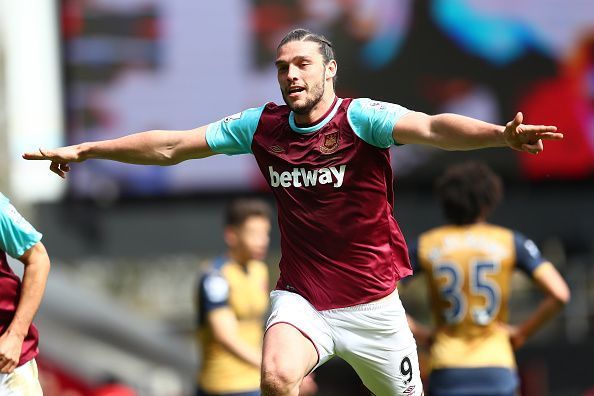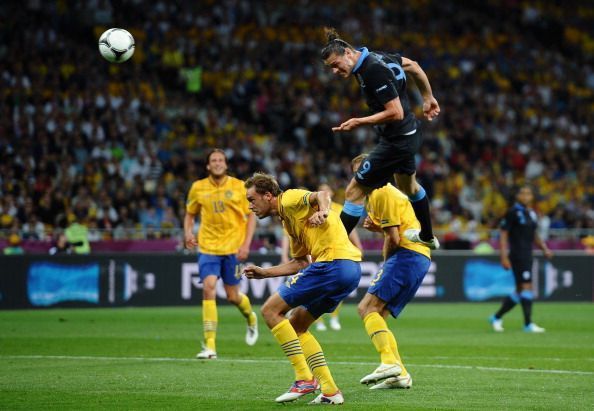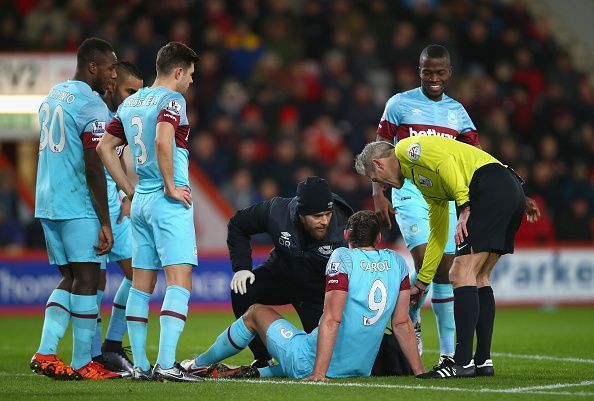
A man out of time - does Andy Carroll have anything left to offer?

By this point – he’s been around for practically a decade now – it’s become cliché to label Andy Carroll as “old-fashioned” or claim that he “came around fifteen years too late”. Sure, he’s a powerful centre-forward in the Alan Shearer model, a man who’s style may well have been suited to the 1980’s or early 1990’s, but does that really mean he’s a man out of time who has nothing left to offer anymore? I’m not so sure.
Initially, when he broke through at Newcastle United as a product of their youth academy, he looked indeed like the sort of player who could go on to finally become a replacement for Shearer at St. James’s Park, a new “local hero” for the Geordie fans to worship.
Carroll broke through into Newcastle’s first team in the 2008/09 season, and although the Magpies were relegated that season, the emergence of Carroll was one of the few plus points for them.
The summer of 2009 saw most of Newcastle’s top strikers – Michael Owen and Mark Viduka amongst others – depart St. James’s, a move which left Carroll as the new top dog. And in his lone season in the Championship, he stepped up to the plate and more.
Carroll was practically an ever-present as Newcastle won the league, finishing as their top goalscorer with 17 in the Championship alone. Any fears of him being unable to adapt to life in the Premier League after promotion were soon abetted as well.
Carroll hit 11 goals in 19 games as Newcastle’s new #9 as 2010/11 began, including his first career hat-trick in a win over Aston Villa early in the season. But despite signing a new five-year deal with the Magpies in October 2010, things were about to change dramatically.
When Liverpool sold Fernando Torres to Chelsea for £50m in the January 2011 transfer window, they needed to make a big move to replace him, and in Newcastle’s young hotshot, they found their man. A £35m bid took him to Anfield, where he was expected to continue on his path to the top.
Unfortunately, it didn’t quite work out that way. Sidelined with injury for a while before he was even able to make his debut, Carroll only made 7 Premier League appearances for Liverpool in his debut season. 2011/12 was where he was expected to make a bigger mark, but unfortunately – again largely due to issues surrounding his fitness – he didn’t play quite as much as was expected.
By the end of the season though, Carroll was on fire, heading in a pair of late winners in a league game against Blackburn that broke a winless streak of four games for Liverpool, and then, more importantly, the winner in the FA Cup semi-final against Mersey rivals Everton.
Carroll also starred for England that summer in the 2012 European Championships, starting their second group game against Sweden and scoring a tremendous header to put England 1-0 up.
It seemed like his career was back on track, but with Brendan Rodgers now installed as Liverpool’s new manager, it quickly became clear that his style of play didn’t mesh with Carroll’s. The big striker was shipped out on loan to West Ham for a season and he’s been there since, after making a permanent move in the summer of 2013.

Since then, Carroll has seen his career largely meander. Issues with his fitness and persistent injuries have kept him on the sidelines for huge swathes of his Hammers career, restricting him to just 74 total Premier League appearances in the four seasons since his permanent move.
And while he’s shown flashes of brilliance – witness his bicycle kick against Crystal Palace in January 2017 – he’s also not really reached his early potential. So at the age of 28, does Carroll actually have anything left to offer at the top level?
On his day, Carroll is undoubtedly one of the most dangerous strikers in the Premier League. He’s practically unplayable in the air – Slaven Bilic has hailed him as the best in the world when it comes to headers, and while his boss may be slightly biased, he’s certainly in the reckoning – but he’s also athletic, deceptively quick and he also has a deft touch for a big man.
And after all, other big men are currently succeeding as top level strikers. Romelu Lukaku, for instance, is on fire at Manchester United, although he relies more on his pace and strength on the ground rather than in the air. And Zlatan Ibrahimovic remains one of the most accomplished forwards in the world, although he too has a very different style to that of Carroll.
The problem might be that the best way to utilise Carroll – the long ball, allowing him to hold the ball up for a smaller striker or get onto the end of crosses and aerial passes – is seen as outdated and unfashionable these days.
The style of play was in vogue in the 1980’s and early 1990’s, but with newer styles such as tiki-taka and the gegenpressing popularised now, it’s hard to imagine a return for long-ball play, particularly as the style is hardly aesthetically pleasing. That’s unfortunate for Carroll, but the problem may be with the observers, not the style – after all, when deployed correctly, it can be devastating.
Look at Euro 2016, for instance, and England’s disastrous game against Iceland. Iceland outfought and out-thought England on that day, but had the Three Lions been able to call upon Carroll, played the long ball to him, allowed him to muscle into the big Icelandic defenders and used the pace of Kyle Walker and Danny Rose to deliver crosses into the box, then the result could well have been different.
But England simply had too many other strikers in the squad – quicker, pacier finishers like Daniel Sturridge and Jamie Vardy – and Carroll was at home, largely ignored and unable to make an impact.
It could be argued that Carroll has damaged himself, too. While it’s hard to blame a poor injury record on the player himself, in Carroll’s case people may have a point. His early career at Newcastle was blighted with indiscipline, including unsavoury incidents that saw him charged with common assault following a nightclub brawl, an altercation with teammate Steven Taylor that left Taylor with a broken jaw, and an alleged assault on a then-girlfriend.
Since moving away from Newcastle Carroll has claimed to be a reformed character, and it is true that no similar incidents have been reported. That doesn’t necessarily mean however that his off-field lifestyle has improved in order to help with his fitness. It’s all conjecture, though, admittedly.

On the pitch, his discipline hasn’t really come into question prior to his recent sending off for two incidents against Burnley. But it is true that referees never favour the physical style that Carroll deploys – in the modern game, such physicality is often frowned upon, much to the disgust of old-school viewers, and so the defender is often favoured in any 50/50 challenges, particularly the aerial ones that Carroll loves. Unfortunately though, it’s another mark against him.
For me, Carroll could still make an impact, both for club and country. He’s such a unique player that when used correctly, within the right tactical gameplan, he could still do massive amounts of damage to practically any defence in the world.
That certainly rings true at international level, where more cultured defenders aren’t used to dealing with such a physical specimen. But it may be a case that he needs to find a manager who can work to his strengths – perhaps West Ham will bring such a man in, once Bilic is inevitably removed from power (which, given the Hammers’ current form seems likely) – or perhaps a move to a more direct-playing side will be needed.
If he can help himself by staying fit – as much as that is possible – then the future could still be bright for a player once seen as the next Alan Shearer. Even if he is a man out of time.